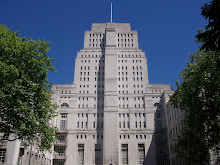
ON PAPER
A symposium exploring the meanings of the material page in the era of the digital text
Friday 30 April 2010 Senate House, The Beveridge Hall
A day of short presentations and paper fondling. Respondent: Professor Esther Leslie.
Co-sponsored by In The Shadow of Senate House.
Sparked by thoughts on the situation of Senate House Library, financially beleaguered and facing spiraling costs for space and building maintenance, this symposium considers the world of the book and a world after the book. Recent strategy documents, in line with a wider rebranding of libraries, signal a continuing move away from book storage towards a new ethos of 'information work'. Increasing use of electronic texts not only enable the library to 'cease investing in the superseded' but also place 'pre-digital' holdings under a process of 'ongoing review'. Such statements do not mean that paper's disappearance is imminent, of course, but they might reveal something about its altered status in the digital era: the printed matter that formerly constituted the library now mainly constitutes a threat to its efficiency and financial viability, in other words. Friedrich Kittler has argued that paper's monopoly as a storage medium once rendered it transparent. In the age of its supposed technological obsolescence, by contrast, it seems likely to re-emerge in all of its singularity, its quirks, its limitations, and above all its material presence.
On Paper is a one day symposium inviting reflections on the now- 'superceded', 'pre-digital' page. Via short, research-based presentations, participants are invited to consider what is lost in the transition from page to screen, and in what ways our practices of literacy have been dependent on the material surface of paper. What role do the physical inscriptions and marks of typography and illustration play in a text's meaning? Should reading and writing be understood in corporeal, tactile or sensual terms as well as visual ones, or does our interaction with the medium of paper involve emotional or psychological investments that are even more difficult to quantify? And if (as anxieties about its storage attest) the printed page has physical dimensions as well as semiotic ones, then how can critical practice account for both? What kind of methodologies allow us to approach texts in with a sensitivity to their matter as well as their meaning? Finally, in what ways has literature either reflected on its own material medium, or imagined the paper archive? By thinking these issue across different periods and genres, the intention is to spark debate and dialogue about the place paper occupies in the current disciplinary practice of Literature.
PROVISIONAL PROGRAMME:
10.30am Coffee and registration
11.00am WELCOME and opening remarks
11.15-12.15 PANEL 1: SERIALS / NEWSPAPERS / COMICS (Chair: TBA)
Tony Venezia (Birkbeck College), 'Alan Moore and the Material Text: The Case of The Mirror of Love'
Zara Dinnen (Birkbeck College), 'Object McSweeney's: Fetishising print in the Digital Age'
Laurel Brake (Birkbeck College), 'Paper Chains/Paper Dreams? Reading nineteenth-century serials online and on paper'
12.15-1.15pm Lunch (own arrangements)
1.15-1.45pm Book artist and graphic designer Linda Toigo will present some of her work
1.45-3.00pm PANEL 2: READING THE SURFACE (Chair: Joe Brooker)
Luisa Calé (Birkbeck), 'Reading and Cutting through the Surface: William Blake's extra-illustrated page from paper to print and screen'
Heather Tilley (Birkbeck College), 'The "feeling reader": embossed books for blind people in the nineteenth century'
Patrizia di Bello (Birkbeck), 'The Sculptures of Picasso with Photos by Brassai'
Henderson Downing (Birkbeck), '"A modernist collage of found objects": the Second Education of Iain Sinclair'
3.00-3.30pm Coffee
3.30- 4.30pm PANEL 3: MARKING THE SURFACE (Chair: Gill Partington)
Adam Smyth (Birkbeck College), 'Collage: Reconsidering Renaissance Writing'
Ros Murray (Kings College), 'Scrapings of the Soul: Artaud's Cahier 395' '
Anthony Bale (Birkbeck College), 'Medieval graffiti, Digitization and the Emotional Archive'
4.00-5.00pm Response from Professor Esther Leslie, followed by round table discussion.
6.00pm Wine reception
Supported by "In the Shadow of Senate House", Birkbeck College, and the National Research Training Scheme in English Language and Literature, Palaeography and the History of the Book administered by the Institute of English Studies, School of Advanced Study, University of London.








